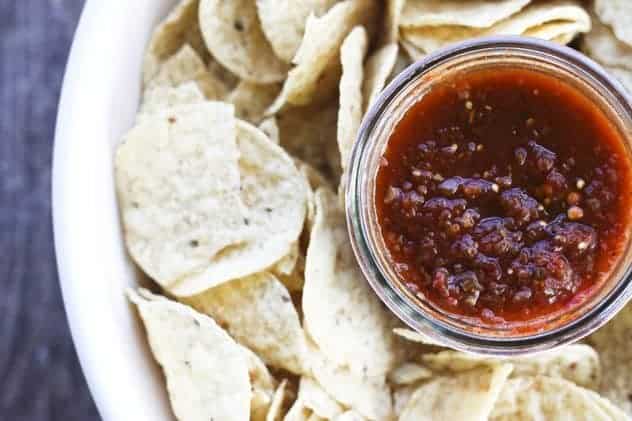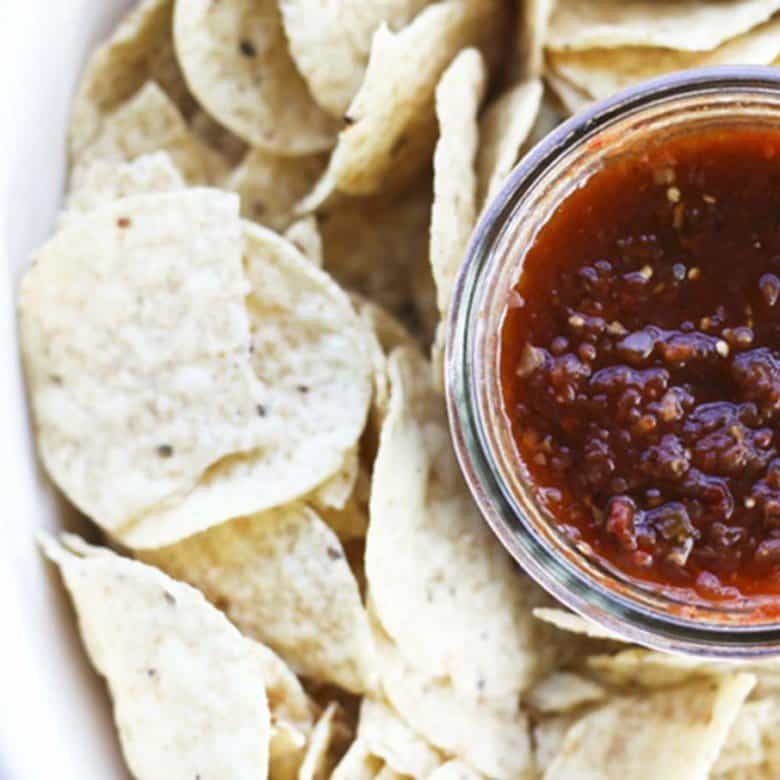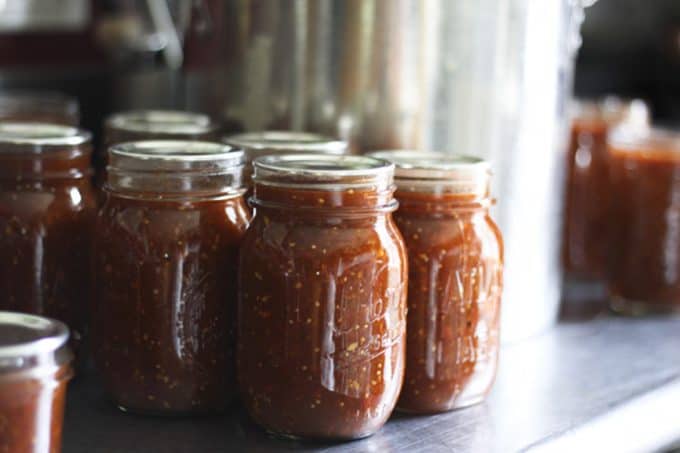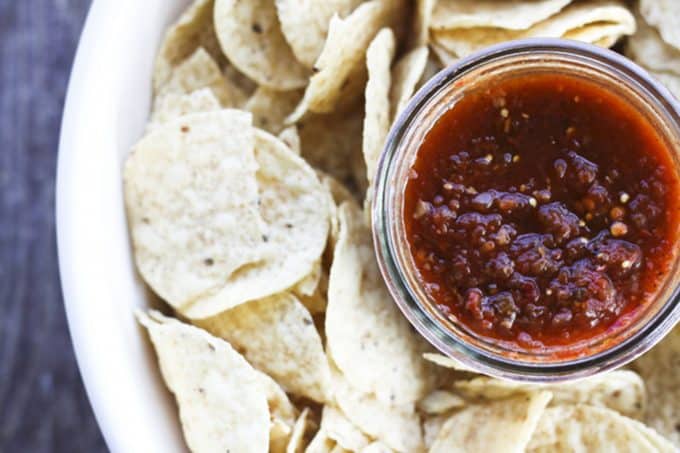This Smoky Roasted Salsa is the little black dress of the salsa world; non-traditional, smoky, fine-textured, and slightly spicy with a bold flavour that’ll knock you out, this salsa is equally wonderful when dunked with chips, poured over meats in a slow-cooker, or spooned and baked on enchiladas. I have yet to find a commercially available salsa that matches this for depth, complexity, and utter fabulousness. I make this salsa in bulk -to the tune of a bushel each of tomatillos and plum tomatoes- every summer because the boys and their friends alike act neglected and depressed if we run out before summer rolls around. While it is far and away best when prepared in season, you can make it year ‘round in a salsa emergency. Believe me when I tell you if you run out, it will be a salsa emergency.
Are you ready for some salsa? It’s a salsa time of year, after all. Now is the time for all good tomatoes to come to the aid of the salsa. Salsasalsasalsasalsasalsasalsasalsasalsa!
Clapclap. Clap. Clap. Clap. Clapclap. Clap. Clap. Clap. Ahem. That’s a salsa beat. Trust me.
It’s not that I get carried away over salsa in general, but I do over Smoky Roasted Salsa. Aside from fresh salsa (pico de gallo, or whathaveyou) this is what every single little salsa wants to be when it grows up. It’s smoky, thick, brick-red, and vibrant with guajillo and chipotle chiles, roasted tomatoes and tomatillos, and garlic that you forget you’re eating a jarred salsa. This is the salsa that makes people stop and say, “WOW!” and “Where’d you get this?” That, my friends, is no time for humility. Show them the rows of this on your shelves and puff your chest out a bit and say, “I made it.” I’d advise you fix a dollar amount in your head before serving to company, though, because you will inevitably be asked by reasonable people how much you would charge for a jar of Smoky Roasted Salsa.
Unreasonable people, or younger siblings, however, will ask, beg and plead for you to give them a jar for free and remind you of the fact that they never told mom that you made them wear your fluffy pink nightgown in exchange for playing Hot Wheels and Matchbox cars with them even though they still don’t know you would’ve played it anyway because you liked them better than Barbies anyway.
It is best to be prepared is my point.
Back to the salsa. There are a few key points that differentiate this salsa from your average chunky jarred stuff.
Cook’s Notes
- Be sure to use dried, reconstituted chiles instead of fresh ones or powdered ones. For some reason this just feels so much easier. Am I crazy? Maybe. But this is what my brain says and I’m listening.
- If your dried peppers are questionable in age, use a damp paper towel to wipe them clean before toasting. This will help remove any dust that is clinging to the outside of the chiles.
- Be sure to use a rimmed baking sheet for roasting your tomatoes, tomatillos, onions, and garlic. This will keep the juices that they inevitably give off as they roast. Be sure to add those accumulated juices to the food processor when you pulse the goodies. No juice left behind!
- Use care when handling and cutting the roasted onions and garlic. They stay hot on the inside far longer than you might think and are a little slippery. You don’t need to have perfectly cut onions and garlic since they will be pulsed in the food processor.
- When you pulse the tomatoes in the food processor or blender, you can stop as chunky or make it as smooth as you’d like. We prefer a smoother texture in this salsa and take it almost all the way to perfectly smooth with just a few bits of recognizable tomato. That makes the texture more of a thick sauce, but that is how we like it.
- Super fresh tomatoes can contain a great deal of naturally occurring pectin. It isn’t always an issue, but what this means practically is that your salsa may be quite a bit thicker in the jar after sitting on the shelf than it was when you put it into the jar. No worries. It is still good to eat. It’s just that pesky pectin butting in where it isn’t wanted. Just break it up a bit with a fork before serving and it will be liquid.
- Be sure to pick tomatillos that are ripe. You can tell this by looking at the papery husk, it should be split in a couple of places. If the fruit is green-ish, it will have the most flavour. Yellow and purple ones will be sweeter and more mild.
- Smoky Roasted Salsa is a “ground” salsa. Instead of uniformly (and angrily, depending on how much salsa you’re making and how many times you’re interrupted by the people who will eventually eat this salsa) hand chopping all the prepared ingredients, you toss them into the food processor and pulse until all the contents have been chopped to the point where they’re pretty darned little. Almost (but not quite) smooth. Why? Well, because I can. And because it tastes great. And because my kids like it better that way. And because it makes this end product more versatile. You can dump a jar on a pork or beef roast or a whole chicken, marinate it overnight, then drop it in the crockpot the next day on low. After several hours, shred everything together for the ultimate in simple main dishes. Eat the meat on sandwiches, on barbecue pizzas, in quesadillas, in this glorious dish, or on tacos. I guarantee you’ll come up with many more ways to use meat cooked in this salsa.
- I have one final piece of advice about Smoky Roasted Salsa. Double the recipe. You really should just trust me on this or one of two things will happen to you. You will find yourself crying over your last jar of salsa between bites ~OR~ you will be reduced to guarding your stash jealously, suspiciously staring down anyone walking past your pantry or basement stairs and menacingly slapping a wooden spoon against your palm to show them you mean business. It will be easier on your mind in the long run if you just go ahead and double it. You’ve been warned.
Use this to make Smoky Roasted Salsa
- sheet pan
- THIS food processor
- stainless steel pot
- long handled spoon
- ladle
- water bath canner
- pint jars

Smoky Roasted Salsa
Rate RecipeReprinted from "Not Your Mama's Canning Book"
Ingredients
- 12 dried chipotle peppers stems and seeds removed
- 12 dried guajilllo peppers stems and seeds removed
- 2 cups boiling water
- 2 small to medium sized onions
- 1 head garlic separated into cloves but not peeled
- 2 lbs plum or Roma tomatoes
- 2 lbs tomatillos husks removed
- 1 cup bottled lime juice
- 1 tablespoon honey agave, or raw sugar
- 1 1/2 teaspoons kosher salt
Instructions
- In a heavy, dry skillet (cast iron, for example) toast the chiles in batches until pliable. Place in a stainless steel or glass bowl. Pour boiling water over the chiles and weigh down with a plate or weight. Let soak for 20 minutes.
- Meanwhile, place the tomatillos, tomatoes, onions, and garlic on a half sheet pan under the broiler. Turn all of them occasionally until blistered all over and blackened in places.
- Transfer the tomatillos to a blender or food processor. Pulse until smooth: add to a large stockpot. Transfer the onions and garlic to a cutting board. Leave the tomatoes in the half sheet pan and cover with a second, inverted sheet pan or with plastic wrap to allow it to cool.
- While the tomatoes cool, peel and roughly chop the onions and garlic. Add them to the blender or food processor and pulse until finely chopped or smooth. Add to the tomatillos in the stockpot.
- Add the soaked chile peppers to the blender or food processor, strain the soaking liquid through a fine mesh sieve, add the liquid to the food processor or blender, and blend on high until smooth. Add to the stockpot.
- Turn your attention to the tomatoes. The skins should peel easily from the tomatoes. Discard the skins and add the tomatoes and juice to the blender. Pulse until the tomatoes are your desired texture. (See Cook’s Notes)
- Add to the stockpot with the lime juice, honey, sugar, or agave, and salt. Bring to a boil, stirring frequently to prevent scorching. Lower heat to medium, and simmer for 15 minutes or until slightly less thick than ketchup. Ladle into prepared pint or half pint jars to within 1/2-inch of the rim. Fix jar lids in place and tighten appropriately.
- Use canning tongs to transfer jars to a boiling water canner with boiling water to cover by 2 inches. Put the canner lid in place and bring to a full rolling boil. Boil for 15 minutes. Transfer jars to a wire rack or towel lined counter. Cool completely (at least 12 hours) before removing rings, wiping clean, and labeling. Store in a cool, dark place for up to a year.
Nutritional information is an estimate and provided to you as a courtesy. You should calculate the nutritional information with the actual ingredients used in your recipe using your preferred nutrition calculator.
did you make this recipe?
Make sure to tag @foodiewithfam on Instagram and #hashtag it #foodiewithfamily so I can check it out!
This post was originally published September 14, 2011. Updated September 2017 with improved cook’s notes, tools, and the refined, adapted recipe as it appeared in Not Your Mama’s Canning Book.







Reader's Thoughts...
Lisa says
This is the best chipotle salsa. The first few times I made it I didn’t pay attention to what kind of peppers they were, Meca or Morita, now that I know they are different I’m not sure which ones to order. I have to order online. Which do you use?
I love your cookbook “Not you mommas canning book”